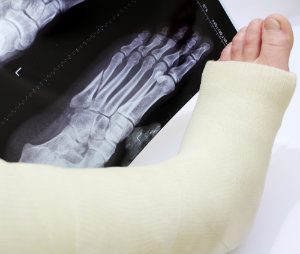Mending Metatarsal Fractures in Your Feet
You drop a heavy box on your foot at work or twist it badly when you land from a jump shot during a pickup basketball game. Your daughter goes out for soccer and her foot gets stomped on during practice. Each of these activities could cause a metatarsal fracture, but so could long training runs or starting boot camp in the military. Any activity that puts unusual pressure on the bones could end up giving you a broken foot.
Analyzing Your Anatomy from Heel to Toe
The bones of your foot are connected in this order:
- Your heel bone rests below the ankle, which joins the leg bones and talus.
- Ahead of it are the midfoot bones (navicular, cuneiform, and cuboid bones) that form your upper arch.
- Next come the metatarsals—the long, thin foot bones.
- And finally, your toe bones (phalanges)
With your ligaments, tendons, and muscles, these feet bones enable the up-and-down, back-and-forth movements of your feet to help you balance, walk, and run. They also provide a sound foundation for your whole body. That’s a lot of pressure, and your metatarsals, particularly, are vulnerable to a break.
Types of Metatarsal Fractures
Overuse is the reason behind one type called a stress fracture. With this condition the bone does not break in two but forms small cracks in the hard outer surface. These can be just as painful as a complete break, but in the metatarsals connected to your big and middle toes, they usually heal well using RICE therapy: Resting from activity for four to eight weeks, Icing to numb pain and control inflammation, Compression and Elevation to prevent pooling of blood and fluids that cause swelling and pain. Normally you will be able to resume normal activity after a couple of months.
When the bone breaks completely apart, the treatment depends on which metatarsal and what part of it is fractured, and if it is displaced (out of alignment) or piercing through the skin. The first through fourth metatarsals usually heal quite well with soft dressings, a good supportive shoe, and gradual increase in weight-bearing, even if the bone is slightly out of alignment from side to side. However, if one part of the bone is higher, tenting the skin, the bone may need to be reduced (“set”) to realign it, and treated with a splint and or cast along with keeping the weight off until it heals.
The 5th Metatarsal Is a Special Case
Breaks in this bone connecting to your little toe are the most common—and may be the hardest to deal with. The type of fracture is divided into “zones.” Zone 1 is when a small chip breaks off the bottom of the metatarsal (avulsion fracture) close to where it joins with the toe. This will typically heal fine without surgery but with immobilization in a cast, boot or hard-soled shoe for 6 to 8 weeks.
If the break is in Zone 3—along the shaft—it is often a stress fracture and will heal as described earlier. Surgery would only be required if recovery is taking too long or there is a risk that it could be broken again.
Zone 2 is the problem area. A break in the back part of the bone near the midfoot (Jones fracture) can be a serious issue. The bone will likely need surgery to realign it and fix it in place, and an extended healing time—often 3 to 4 months.
Finding Expert Foot Care in Ladera Ranch, CA
Whether you suspect you have a metatarsal fracture, are dealing with heel pain, or have a bunion that is giving you trouble, the foot specialists at Southern California Foot & Ankle Specialists are here for you. We offer expert care with a caring attitude, and welcome the opportunity to serve you and your family. Just call our office in Ladera Ranch at (949) 364-9255 (WALK) or fill out the contact form to reach us.
Contact Us
Robert Spencer, DPM
Nitza Rodriguez, DPM
Mario Porciello, DPM
Map & Directions
333 Corporate Drive, Suite 230, Ladera Ranch, CA 92694
Tel: (949) 364-9255 (WALK)
Fax: (949) 364-9250
Office Hours:
Monday - Friday: 9am - 5pm
*(Lunch 12 noon - 1pm)

